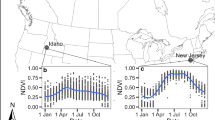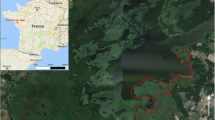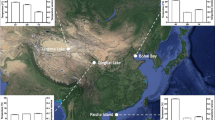Abstract
Examination of spatial and temporal factors that influence nest survival can provide insight into habitat selection, reproductive decisions (e.g., clutch size), population dynamics, and conservation requirements for species. We used nest survival data for the Dusky Flycatcher Empidonax oberholseri to examine several factors that may influence nesting success. Our prediction was that the number of nest initiations would be positively associated with period nest survival. We used a model selection framework and found that nesting success was a function of clutch size and a cubic effect of age. Clutches with one, two, three, and four eggs had period survival rates of 0, 0.05, 0.33, and 0.49, respectively. Daily survival rates decreased from the onset of egg-laying and increased during the later stages of incubation before remaining relatively constant through the later portions of the nestling stage. Model-selection criterion provided support for a date effect on daily survival (i.e., daily nest survival declined across the nesting season) although the 95% confidence interval for the estimate included zero. We found that the majority of nest initiations occurred early in the nest season and declined across the season as period nest survival declined. Our prediction concerning nest survival was partially supported. In addition, we found substantial positive associations between clutch size and nest survival. While low daily survival rates for clutches with one or two eggs suggested that individuals may have reduced reproductive effort in response to nest predation risk, we did not find strong evidence that individuals reduced their clutch sizes in subsequent nest attempts. Alternative predictions, including the preferential settlement of higher quality individuals (e.g., those with the ability to lay full clutches to replace depredated nests) into high-quality habitat and differences in behavior patterns (e.g., number of visits to provision nestlings), may provide more consistent explanations for these patterns.


Similar content being viewed by others
References
Arlt D, Pärt T (2007) Nonideal breeding habitat selection: a mismatch between preference and fitness. Ecology 88:792–801. doi:10.1890/06-0574
Bibby CJ, Burgess ND, Hill DA (1992) Bird census techniques. Academic Press, San Diego
Both C (1998) Experimental evidence for density dependence of reproduction in great tits. J Anim Ecol 67:667–674. doi:10.1046/j.1365-2656.1998.00228.x
Both C, Visser ME (2000) Breeding territory size affects fitness: an experimental study on competition at the individual level. J Anim Ecol 69:1021–1030. doi:10.1046/j.1365-2656.2000.00458.x
Braden GT, McKernan RL, Powell SM (1997) Association of within-territory vegetation characteristics and fitness components of California Gnatcatchers. Auk 114:601–609
Budnik JM, Thompson FRIII, Ryan MR (2002) Effect of habitat characteristics on the probability of parasitism and predation of Bell’s vireo nests. J Wildl Manage 66:232–239. doi:10.2307/3802889
Burhans DE, Thompson FRIII (1998) Effects of time and nest-site characteristics on concealment of songbird nests. Condor 100:663–672. doi:10.2307/1369747
Burhans DE, Thompson FRIII (2001) Relationship of songbird nest concealment to nest fate and flushing behavior of adults. Auk 118:237–242. doi:10.1642/0004-8038(2001)118[0237:ROSNCT]2.0.CO;2
Burnham KP, Anderson DR (2002) Model selection and multimodel inference: an information-theoretic approach. Springer, New York
Chalfoun AD, Ratnaswamy MJ, Thompson FRIII (2002) Songbird nest predators in forest-pasture edge and forest interior in a fragmented landscape. Ecol Appl 12:858–867
Cresswell W (1997a) Nest predation rates and nest detectability in different stages of breeding in blackbirds Turdus merula. J Avian Biol 28:296–302. doi:10.2307/3676942
Cresswell W (1997b) Nest predation: the relative effects of nest characteristics, clutch size and parental behavior. Anim Behav 53:93–100. doi:10.1006/anbe.1996.0281
Daunt F, Wanless S, Harris MP, Monaghan P (1999) Experimental evidence that age-specific reproductive success is independent of environmental effects. Proc R Soc Lond B Biol Sci 266:1489–1493. doi:10.1098/rspb.1999.0805
Davis SK, Brigham RM, Shaffer TL, James PC (2006) Mixed-grass prairie passerines exhibit weak and variable responses to patch size. Auk 123:807–821. doi:10.1642/0004-8038(2006)123[807:MPPEWA]2.0.CO;2
Dinsmore SJ, White GC, Knopf FL (2002) Advanced techniques for modeling avian nest survival. Ecology 83:3476–3488
Doligez B, Clobert J (2003) Clutch size reduction as a response to increased nest predation rate in the collared flycatcher. Ecology 84:2582–2588. doi:10.1890/02-3116
Eggers S, Griesser M, Nystrand M, Ekman J (2006) Predation risk induces changes in nest-site selection and clutch size in the Siberian jay. Proc R Soc Lond B Biol Sci 273:701–706. doi:10.1098/rspb.2005.3373
Filliater TS, Breitwisch R, Nealen PM (1994) Predation on northern cardinal nests: does choice of nest site matter? Condor 96:761–768. doi:10.2307/1369479
Fontaine JJ, Martin TE (2006a) Habitat selection responses of parents to offspring predation risk: an experimental test. Am Nat 168:811–818. doi:10.1086/508297
Fontaine JJ, Martin TE (2006b) Parent birds assess nest predation risk and adjust their reproductive strategies. Ecol Lett 9:428–434. doi:10.1111/j.1461-0248.2006.00892.x
Franklin AB, Anderson DR, Gutiérrez RJ, Burnham K (2000) Climate, habitat quality, and fitness in northern spotted owl populations in northwestern California. Ecol Monogr 70:539–590
Grant TA, Shaffer TL, Madden EM, Pietze PJ (2005) Time-specific variation in passerine nest survival: new insights into old questions. Auk 122:661–672. doi:10.1642/0004-8038(2005)122[0661:TVIPNS]2.0.CO;2
Grant TA, Madden EM, Shaffer TL, Pietz PJ, Berkey GB, Kadrmas NJ (2006) Nest survival of clay-colored and vesper sparrows in relation to woodland edge in mixed-grass prairies. J Wildl Manage 70:691–701. doi:10.2193/0022-541X(2006)70[691:NSOCAV]2.0.CO;2
Haskell DG (1999) The effect of predation on begging-call evolution in nesting wood warblers. Anim Behav 57:893–901. doi:10.1006/anbe.1998.1053
Hazler KR (2004) Mayfield logistic regression: a practical approach for analysis of nest survival data. Auk 121:707–716. doi:10.1642/0004-8038(2004)121[0707:MLRAPA]2.0.CO;2
Hazler KR, Amacher AJ, Lancia RA, Gerwin JA (2006) Factors influencing acadian flycatcher nesting success in an intensively managed forest landscape. J Wildl Manage 70:532–538. doi:10.2193/0022-541X(2006)70[532:FIAFNS]2.0.CO;2
Högstedt G (1980) Evolution of clutch size in birds: adaptive variation in relation to territory quality. Science 210:1148–1150. doi:10.1126/science.210.4474.1148
Holmes RT, Marra PP, Sherry TW (1996) Habitat-specific demography of breeding black-throated blue warblers (Dendroica caerulescens): implications for population dynamics. J Anim Ecol 65:183–195. doi:10.2307/5721
Hosmer DW, Lemeshow S (2000) Applied logistic regression. Wiley, New York
Kelly JP (1993) The effect of nest predation on habitat selection by dusky flycatchers in limber pine-juniper woodland. Condor 95:83–93. doi:10.2307/1369389
Kroll AJ (2004) Habitat selection and use by the dusky flycatcher (Empidonax oberholseri) at multiple scales: implications for habitat-based methods for population viability analysis. Wildlife Biology Program, University of Montana, Missoula
Kroll AJ, Haufler JB (2007) Evaluating habitat quality for the dusky flycatcher. J Wildl Manage 71:14–22. doi:10.2193/2005-452
Leech SM, Leonard ML (1997) Begging and the risk of predation in nestling birds. Behav Ecol 8:644–646. doi:10.1093/beheco/8.6.644
Lloyd JD, Martin TE (2005) Reproductive success of chestnut-collared longspurs in native and exotic grassland. Condor 107:363–374. doi:10.1650/7701
Martin TE (1995) Avian life history evolution in relation to nest sites, nest predation, and food. Ecol Monogr 65:101–127. doi:10.2307/2937160
Martin TE (1996) Fitness costs of resource overlap among coexisting bird species. Nature 380:338–340. doi:10.1038/380338a0
Martin TE (1998) Are microhabitat preferences of coexisting species under selection and adaptive? Ecology 79:656–670
Martin TE, Bassar RD, Bassar SK, Fontaine JJ, Lloyd P, Mathewson HA, Niklison AM, Chalfoun AD (2006) Life-history and ecological correlates of geographic variation in egg and clutch mass among passerine species. Evolution 60:390–398
Martin TE, Geupel GR (1993) Nest-monitoring plots: methods for locating nests and monitoring success. J Field Ornithol 64:507–519
Martin TE, Ghalambor C (1999) Males helping females during incubation. I. Required by microclimate or constrained by nest predation? Am Nat 153:131–139. doi:10.1086/303153
Martin TE, Roper JJ (1988) Nest predation and nest-site selection of a western population of the Hermit Thrush. Condor 90:51–57. doi:10.2307/1368432
Martin TE, Scott J, Menge C (2000) Nest predation increases with parental activity: separating nest site and parental activity effects. Proc R Soc Lond B Biol Sci 267:2287–2293. doi:10.1098/rspb.2000.1281
Mayfield HF (1975) Suggestions for calculating nesting success. Wilson Bull 87:456–466
Mitchell WA, Brown JS (1990) Density-dependent harvest rates by optimal foragers. Oikos 57:180–190. doi:10.2307/3565938
Nagy LR, Holmes RT (2005) Food limits annual fecundity of a migratory songbird: an experimental study. Ecology 86:675–681. doi:10.1890/04-0155
Olendorf R, Robinson SK (2000) Effectiveness of nest defense in the Acadian flycatcher Empidonax virescens. Ibis 142:365–371. doi:10.1111/j.1474-919X.2000.tb04432.x
Pärt T (2001) Experimental evidence of environmental effects on age-specific reproductive success: the importance of resource quality. Proc R Soc Lond B Biol Sci 268:2267–2271. doi:10.1098/rspb.2001.1803
Peak RG, Thompson FRIII, Shaffer TL (2004) Factors affecting songbird nest survival in riparian forests in midwestern agricultural landscapes. Auk 121:726–737. doi:10.1642/0004-8038(2004)121[0726:FASNSI]2.0.CO;2
Petit LJ, Petit DR (1996) Factors governing habitat selection by prothonotary warblers: field tests of the Fretwell–Lucas models. Ecol Monogr 66:367–387. doi:10.2307/2963523
Rastogi AD, Zanette L, Clinchy M (2006) Food availability affects diurnal nest predation and adult antipredator behaviour in song sparrows, Melospiza melodia. Anim Behav 72:933–940. doi:10.1016/j.anbehav.2006.03.006
Rodenhouse NL, Holmes RT (1992) Results of experimental and natural food reductions for breeding black-throated blue warblers. Ecology 73:357–372. doi:10.2307/1938747
Roos S (2002) Functional responses, seasonal decline, and landscape differences in nest predation risk. Oecologia 133:608–615
Rotella JJ, Dinsmore SJ, Shaffer JA (2004) Modeling nest-survival data: a comparison of recently developed methods that can be implemented in MARK and SAS. Anim Biodivers Conserv 27:187–205
Rowe L, Ludwig D, Schluter D (1994) Time, condition, and the seasonal decline of avian clutch size. Am Nat 143:698–722. doi:10.1086/285627
SAS Institute (2004) The SAS system for Windows, ver. 9.1. SAS Institute, Cary
Schmidt KA, Whelan CJ (1999a) Nest placement and mortality: is nest predation a random event in space and time? Condor 101:916–920. doi:10.2307/1370089
Schmidt KA, Whelan CJ (1999b) Nest predation on woodland songbirds: when is nest predation density dependent? Oikos 87:65–74. doi:10.2307/3546997
Sedgwick JA (1993) Dusky Flycatcher (Empidonax oberholseri). No. 78. In: Poole A, Gill F (eds) The birds of North America. The Academy of Natural Sciences/The American Ornithologists’ Union, Philadelphia/Washington
Shaffer TL (2004) A unified approach to analyzing nest success. Auk 121:526–540. doi:10.1642/0004-8038(2004)121[0526:AUATAN]2.0.CO;2
Sieving KE, Willson MF (1998) Nest predation and avian species diversity in northwestern forest understory. Ecology 79:2391–2402
Slagsvold T (1984) Clutch size variation of birds in relation to nest predation: on the cost of reproduction. J Anim Ecol 53:945–953. doi:10.2307/4669
Sockman KW (1997) Variation in life-history traits and nest-site selection affects risk of nest predation in the California Gnatcatcher. Auk 114:324–332
Sockman KW, Sharp PJ, Schwabl H (2006) Orchestration of avian reproductive effort: an integration of the ultimate and proximate bases for flexibility in clutch size, incubation behavior, and yolk androgen deposition. Biol Rev Camb Philos Soc 81:629–666. doi:10.1017/S1464793106007147
Stamps JA (1990) The effect of contender pressure on territory size and overlap in seasonally territorial species. Am Nat 135:614–632. doi:10.1086/285065
Steele R, Pfister RD, Ryker RA, Kittams JA (1981) Forest habitat types of central Idaho. U.S. Department of Agriculture, Forest Service, Idaho Falls
Van Noordwijk AJ, McCleery RH, Perrins CM (1995) Selection for the timing of great tit breeding in relation to caterpillar growth and temperature. J Anim Ecol 64:451–458. doi:10.2307/5648
Visser ME, Holleman LJM, Gienapp P (2006) Shifts in caterpillar biomass phenology due to climate change and its impact on the breeding biology of an insectivorous bird. Oecologia 147:164–172. doi:10.1007/s00442-005-0299-6
Winkler DW, Allen PE (1996) The seasonal decline in tree swallow clutch size: physiological constraint or strategic adjustment? Ecology 77:922–932. doi:10.2307/2265512
Winter M, Johnson DH, Shaffer JA (2005) Variability in vegetation effects on density and nesting success of grassland birds. J Wildl Manage 69:185–197. doi:10.2193/0022-541X(2005)069<0185:VIVEOD>2.0.CO;2
Zanette L, Doyle P, Trémont SM (2000) Food shortage in small fragments: evidence from an area-sensitive passerine. Ecology 81:1654–1666
Zanette L, Clinchy M, Smith JNM (2006) Food and predators affect egg production in song sparrows. Ecology 87:2459–2467. doi:10.1890/0012-9658(2006)87[2459:FAPAEP]2.0.CO;2
Acknowledgments
The Boise Cascade Corporation provided the funding to undertake this research. We thank G. Roloff, B. Kernohan, D. New, and C. Clay of the Boise Cascade Corporation for their assistance. We thank K. Zarbock, J. Kolar, J. King, M. Mathias, H. Montag, and N. Camberos for their work in Idaho. T. Shaffer provided the code to run the goodness-of-fit test. J. Citta and four anonymous reviewers made comments that improved the manuscript.
Author information
Authors and Affiliations
Corresponding author
Additional information
Communicated by F. Bairlein.
Rights and permissions
About this article
Cite this article
Kroll, A.J., Haufler, J.B. Age and clutch size variation in Dusky Flycatcher nest survival. J Ornithol 150, 409–417 (2009). https://doi.org/10.1007/s10336-008-0353-3
Received:
Accepted:
Published:
Issue Date:
DOI: https://doi.org/10.1007/s10336-008-0353-3




